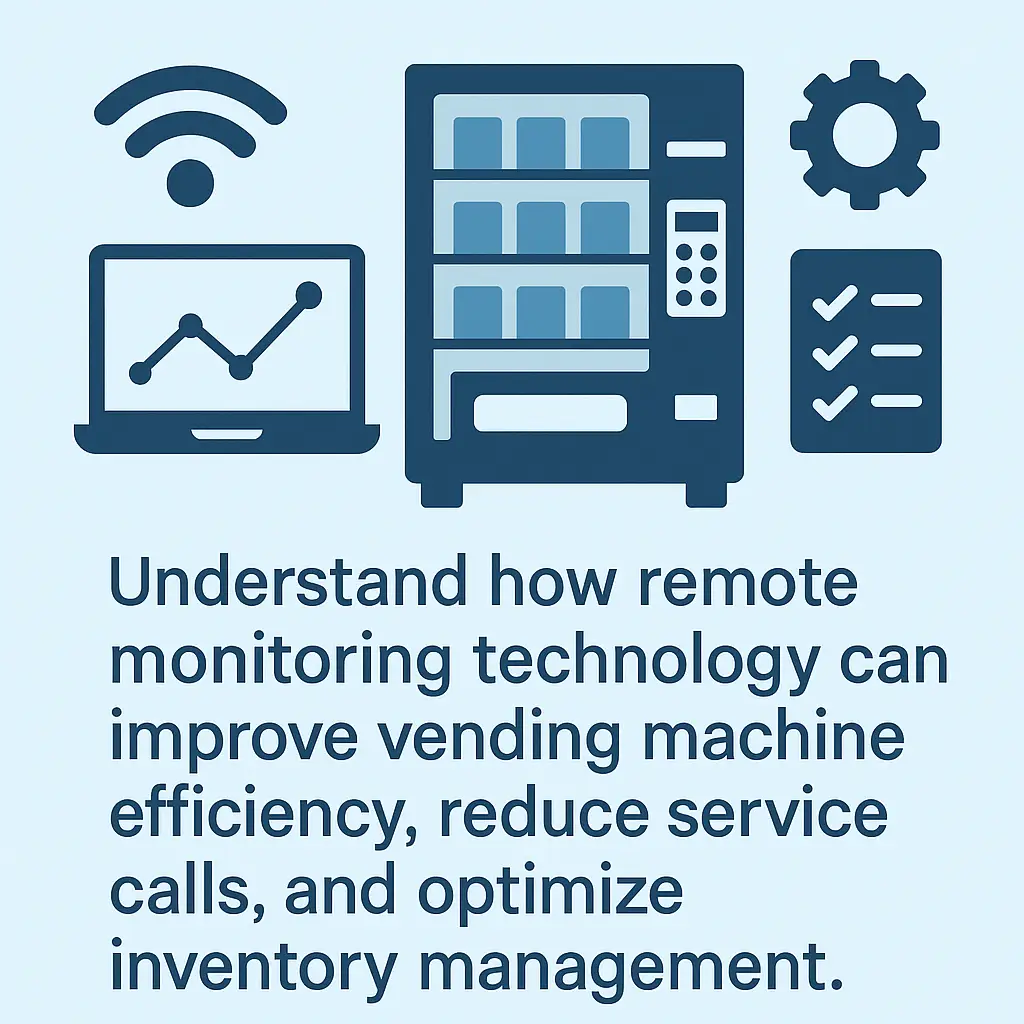Remote Monitoring of Vending Machines
Understand how remote monitoring technology can improve vending machine efficiency, reduce service calls, and optimize inventory management.
Back to Vending Info for Businesses ResourcesUnderstand how remote monitoring technology can improve vending machine efficiency, reduce service calls, and optimize inventory management.
Back to Vending Info for Businesses ResourcesRemote monitoring transforms vending machine operations by providing real-time data on sales, inventory, and machine performance, leading to smarter management and increased profitability.
![]() Real-time inventory data prevents stockouts and optimizes restocking schedules
Real-time inventory data prevents stockouts and optimizes restocking schedules
![]() Instant alerts for machine errors minimize downtime and enhance customer satisfaction
Instant alerts for machine errors minimize downtime and enhance customer satisfaction
![]() Data-driven insights guide product selection and pricing strategies
Data-driven insights guide product selection and pricing strategies

Modern vending machines are no longer just simple mechanical boxes; they are sophisticated retail points that can be managed from anywhere. Remote monitoring technology for vending machines leverages connectivity to provide real-time insights, allowing operators to run their businesses with unprecedented efficiency and precision. This shift from reactive to proactive management minimizes operational costs, maximizes revenue, and significantly improves customer satisfaction.
One of the primary benefits of remote monitoring is its ability to provide accurate, up-to-the-minute inventory levels. This means operators know exactly which products have sold and what needs restocking without needing to physically visit each machine. By tracking individual product sales data, businesses can optimize their product assortment, ensuring popular items are always available and reducing the likelihood of stockouts. This also helps in reducing wasted trips and fuel consumption by only sending service technicians when specific machines genuinely require attention. For more detail on how inventory is tracked, explore information on vending machine inventory tracking technology.
Remote monitoring systems provide instant alerts for machine errors, malfunctions, or even low stock levels. This allows vending operators to address issues proactively rather than waiting for customer complaints. For instance, if a machine's cooling unit begins to fail, the system can send an alert, enabling technicians to intervene before products spoil. Reduced downtime means more consistent sales and a more reliable service for consumers. Understanding how these systems work can shed light on why vending devices often need internet access; read more about whether vending machines need Wi-Fi or power.
By having a clear picture of stock levels and machine performance across an entire fleet, remote monitoring enables dynamic route planning. Service routes can be optimized to only visit machines that genuinely require restocking or maintenance, reducing mileage, fuel costs, and labor hours. This operational efficiency directly translates into significant cost savings and improved profitability. For insights into how service calls are handled, consider this guide on how quickly vending machine service calls are handled. Remote monitoring makes these responses even faster and more targeted.
Implementing remote monitoring technology transforms traditional vending into a smart, data-driven business. It allows for better decision-making, greater operational efficiency, and an enhanced customer experience, positioning vending businesses for sustained growth and success.
Remote monitoring allows vending machine operators to track inventory, sales, and machine status from a distance using an internet connection.
It optimizes routes, reduces unnecessary service calls, prevents stockouts, and provides real-time sales data for better management.
These systems can track current inventory levels, sales per product, cash and cashless transaction data, machine errors, and temperature settings.
Many modern vending machines come with built-in remote monitoring capabilities, and older machines can often be retrofitted with telemetry modules.
It provides precise, real-time inventory counts, allowing operators to know exactly what products are needed before a service visit, minimizing waste and maximizing stock availability.
Yes, by optimizing refill routes, reducing fuel consumption, cutting down on unnecessary trips, and ensuring machines are always stocked with high-demand items.
Reputable remote monitoring systems use secure data encryption and access controls to protect sensitive sales and operational data.
Typically, machines need a telemetry device or board, internet connectivity (cellular or Wi-Fi), and access to a cloud-based software platform.
It ensures machines are consistently stocked with popular items and that technical issues are resolved quickly, leading to a more reliable and satisfying experience for users.
Absolutely. By analyzing sales data, operators can identify top-selling products and slow movers, allowing for data-driven adjustments to product assortments.